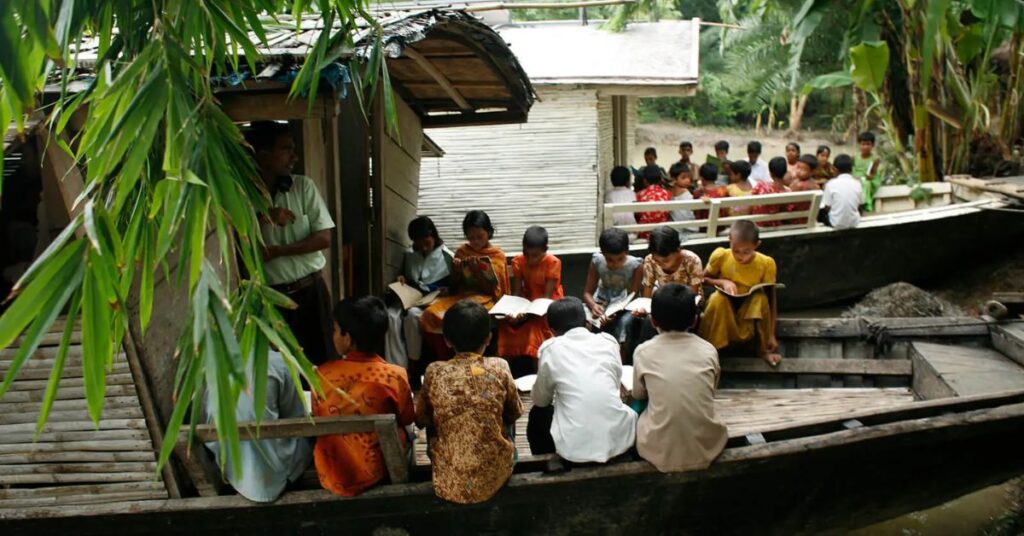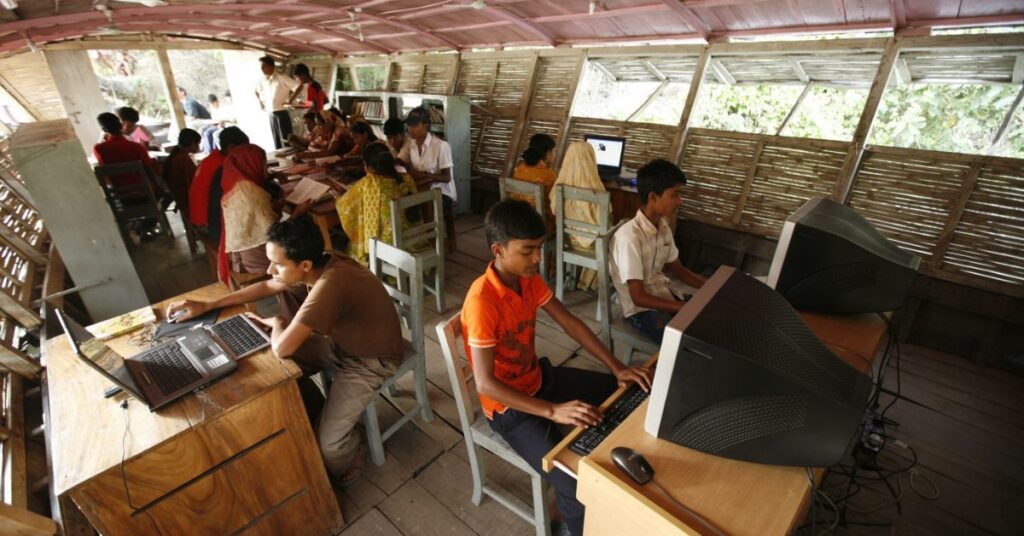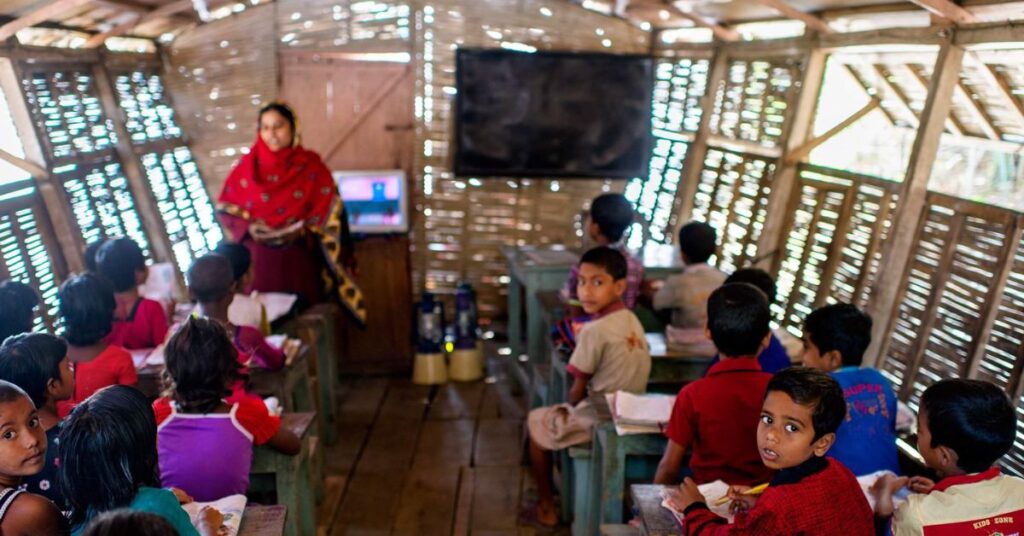Imagine being a child who wakes up each morning, not to catch a school bus, but to wait for a school boat. In the flood-prone villages of Bangladesh, where roads disappear underwater for months every year, education has found an inspiring solution that doesn’t sink when the rains come—floating schools. In a country where over 20% of the land floods annually, these mobile schools are not only ingenious—they’re lifesaving. Powered by solar energy, designed sustainably, and built to float, these schools bring classrooms to the children, ensuring education continues even when the world around them is submerged. This blog takes you inside the heart of Bangladesh’s floating education movement, exploring how architecture, innovation, and community spirit have come together to redefine the future of learning. The Crisis: Climate Change and Education Disruption Bangladesh is one of the world’s most climate-vulnerable nations. Located in the Ganges Delta, much of its population lives near rivers, making them extremely susceptible to: Each year, thousands of schools in rural areas are forced to shut down during flood seasons, leaving millions of children without access to education for months. For many, this temporary pause often becomes permanent dropout. How do you keep children in school when the school itself disappears underwater? The answer came from the people most affected: the villagers themselves. The Solution: Schools That Float with the Floods Enter the floating school model, pioneered by the non-profit Shidhulai Swanirvar Sangstha in 2002. Founded by architect and social entrepreneur Mohammed Rezwan, the organization envisioned …
A Floating School in Bangladesh: Education That Rises with the Water

Imagine being a child who wakes up each morning, not to catch a school bus, but to wait for a school boat.
In the flood-prone villages of Bangladesh, where roads disappear underwater for months every year, education has found an inspiring solution that doesn’t sink when the rains come—floating schools.
In a country where over 20% of the land floods annually, these mobile schools are not only ingenious—they’re lifesaving. Powered by solar energy, designed sustainably, and built to float, these schools bring classrooms to the children, ensuring education continues even when the world around them is submerged.
This blog takes you inside the heart of Bangladesh’s floating education movement, exploring how architecture, innovation, and community spirit have come together to redefine the future of learning.
The Crisis: Climate Change and Education Disruption

Bangladesh is one of the world’s most climate-vulnerable nations. Located in the Ganges Delta, much of its population lives near rivers, making them extremely susceptible to:
- Monsoonal floods
- Rising sea levels
- Riverbank erosion
Each year, thousands of schools in rural areas are forced to shut down during flood seasons, leaving millions of children without access to education for months. For many, this temporary pause often becomes permanent dropout.
How do you keep children in school when the school itself disappears underwater? The answer came from the people most affected: the villagers themselves.
The Solution: Schools That Float with the Floods
Enter the floating school model, pioneered by the non-profit Shidhulai Swanirvar Sangstha in 2002. Founded by architect and social entrepreneur Mohammed Rezwan, the organization envisioned a school that could go to the students, instead of expecting students to come to school.
What Is a Floating School?
A floating school is essentially a solar-powered boat converted into a mobile classroom. It travels to different riverbank communities, anchoring at designated spots where children climb aboard to learn.
Design and Architecture: Where Function Meets Innovation

These schools are more than boats—they are sustainable architectural marvels designed with:
Eco-Friendly Materials:
- Built with locally sourced bamboo, timber, and recycled materials
- Lightweight yet durable to withstand seasonal wear
Solar Energy:
- Solar panels power lights, fans, laptops, and even internet routers
- Enables night classes and digital education, even in off-grid areas
Classroom Design:
- Each boat is approximately 50 feet long
- Capacity for 30 students at a time
- Equipped with whiteboards, bookshelves, desks, and e-learning tools
- Some even have library boats and internet boats that accompany the main classroom vessel
Amphibious Construction:
- Designed to float during floods and rest on land when waters recede
- Flexible, mobile, and easily repairable
Rezwan calls the model “a combination of a school bus and a school building.”
Impact on Education: Numbers That Inspire

Since the first floating school launched in 2002, the initiative has scaled rapidly:
- Over 100 floating schools, libraries, and health boats operate today
- 70,000+ children have benefited directly from the program
- Literacy rates in participating communities have increased significantly
- Girls’ attendance has seen a sharp rise, promoting gender equality in education
These schools have also introduced digital literacy, climate education, and life skills training, preparing students for the challenges ahead—not just academically, but environmentally.
Stories from the River: Lives Changed by Floating Schools
Take Sabina, a 12-year-old from the Gaibandha district. During floods, her family’s house is often isolated for weeks. Before the floating school came, her education would be paused every monsoon. Now, the school boat docks at her doorstep. She studies math, science, and even uses a tablet—all aboard a floating classroom.
Or Mohammad, whose parents are fishermen. Thanks to the mobile school library, he discovered a love for storytelling and now dreams of becoming a writer.
These aren’t isolated stories—they’re ripples of change across an entire generation.
Global Recognition and Awards
The floating school model has attracted international praise and awards, including:
- UNESCO’s Prize for Innovation in Education
- Featured in TIME Magazine, BBC, National Geographic, and CNN
- Case studies by Harvard Graduate School of Education
It’s become a blueprint for climate-resilient education in other countries facing similar challenges, such as Philippines, Cambodia, and Nigeria.
Challenges and Evolution

Like any bold innovation, floating schools face ongoing challenges:
- Funding and maintenance of boats and solar systems
- Internet connectivity in remote regions
- Ensuring qualified teachers are available on-board
To overcome these, organizations like Shidhulai are training local teachers, partnering with tech companies, and building mobile health clinics and floating training centers for adults—creating a holistic floating community model.
Lessons for the World: Innovation Rooted in Local Wisdom
What makes Bangladesh’s floating schools extraordinary is not just their design, but their roots in local knowledge and community resilience.
In a time where billion-dollar cities are struggling to adapt to climate change, these humble boats quietly remind us that innovation doesn’t always need glass towers and artificial intelligence—sometimes, it needs bamboo, solar panels, and the will to educate.
Conclusion: When the Waters Rise, So Does Hope
In Bangladesh, where climate change is not a future threat but a daily reality, floating schools are more than boats—they are beacons of hope. They show the world that even in the most challenging environments, education can—and must—find a way.
As urban planners, educators, architects, and global citizens, we have much to learn from these floating classrooms. In a world seeking sustainable, inclusive solutions, Bangladesh’s floating schools are not just answers—they are inspiration.


